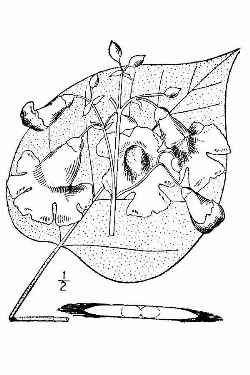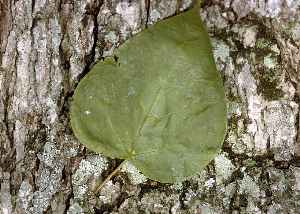
Britton, N.L., and A. Brown. 1913. Illustrated flora of the northern states and Canada. Vol. 3: 20. Courtesy of Kentucky Native Plant Society. Scanned by Omnitek Inc.
Sunset®: All zones
USDA: 4-8
Heat Tolerance: Questionable
Sun Exposure: Full sun, intolerant of shade
Origin: USA (Southern Illinois to Arkansas)
Growth Habits: Deciduous tree, up to 70 feet tall (20 m), 20 to 50 feet spread (6-15 m), leaves 6 to 12 inches long (15-30 cm), sometimes tri-lobed, particularly when young, soft pubescence on the underside, no odor when crushed
Flowers: White or purple flowers
Watering Needs: Little water
Propagation: Seeds, cuttings in late spring or summer, budding or grafting in the fall or winter
Propagation: Seed
- by seeds, in spring. Germinates at 70-85 degrees F. The seeds can be harvested in late winter. No pre-treatment is needed. The usual germination temperature is 70-85 degrees F.

Robert H. Mohlenbrock. USDA NRCS. 1995. Northeast wetland flora: Field office guide to plant species. Northeast National Technical Center, Chester, PA
This Catalpa is the host plant for the catawba worms, caterpillars that are popular fishing bait.

Robert H. Mohlenbrock. USDA SCS. 1991. Southern wetland flora: Field office guide to plant species. South National Technical Center, Fort Worth, TX.
Blooming Habits:
Very showy, tubular flowers, up to 0.4 inch broad (2 cm) in terminal panicle, in May - June. The corolla is white outside, purple and yellow spotted inside. The fruit is an elongate "cigarlike" or "beanlike" capsule, up to 14 inches long (35cm), 0.4 inch in diameter (1cm). The seeds are flattened, with 2-papery, fringed wings.
Desert-Tropicals is dedicated to provide gardening advice, gardening ideas, and information about flower of all kind for landscape and collections.We try to check carefully the identification of the plants on the illustrations as well as the other information from the page, but occasionally errors do occur. if you notice anything that needs to be changed please contact us.Thanks.
© 1998-2020 Philippe Faucon, All Rights Reserved.